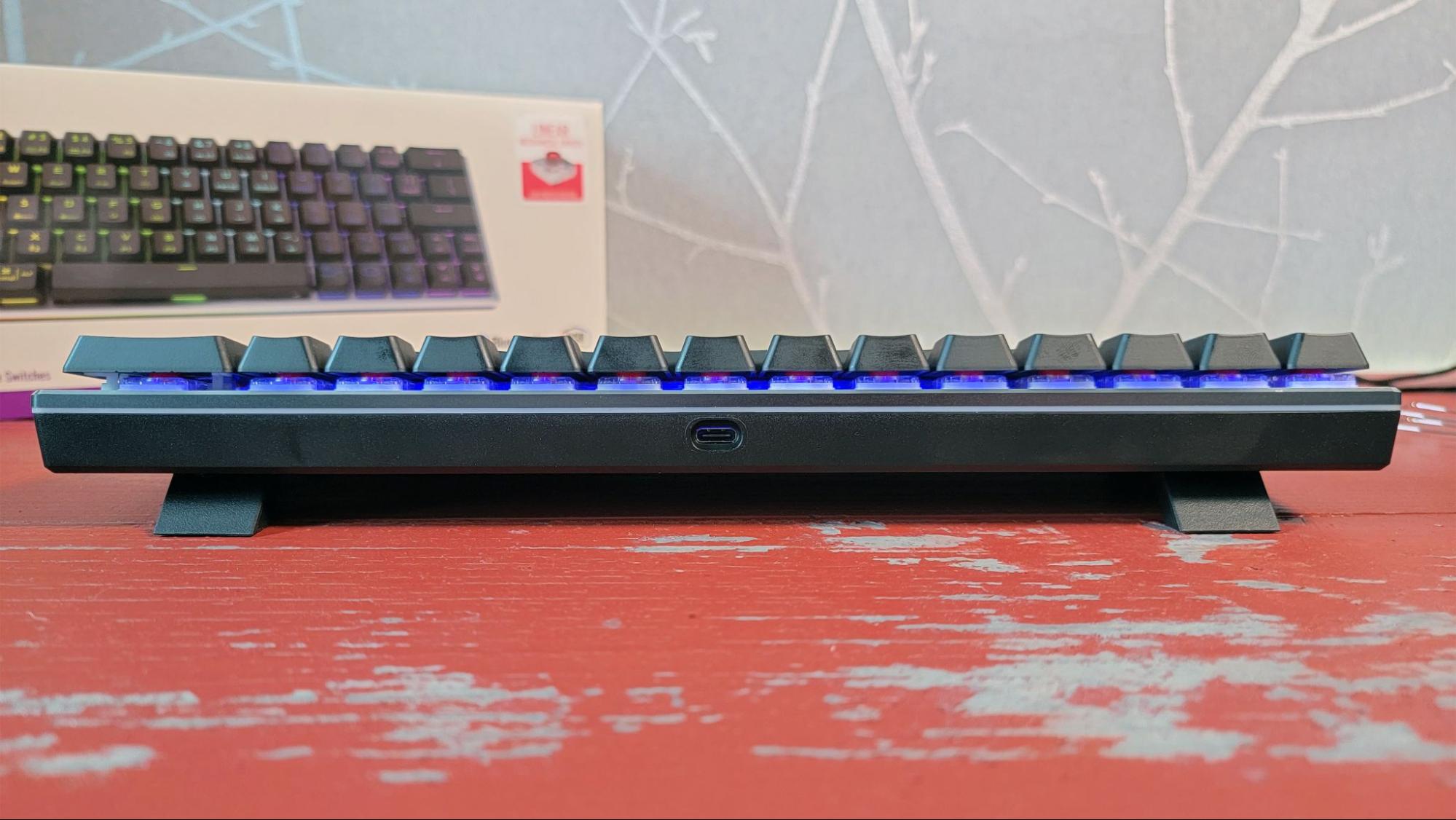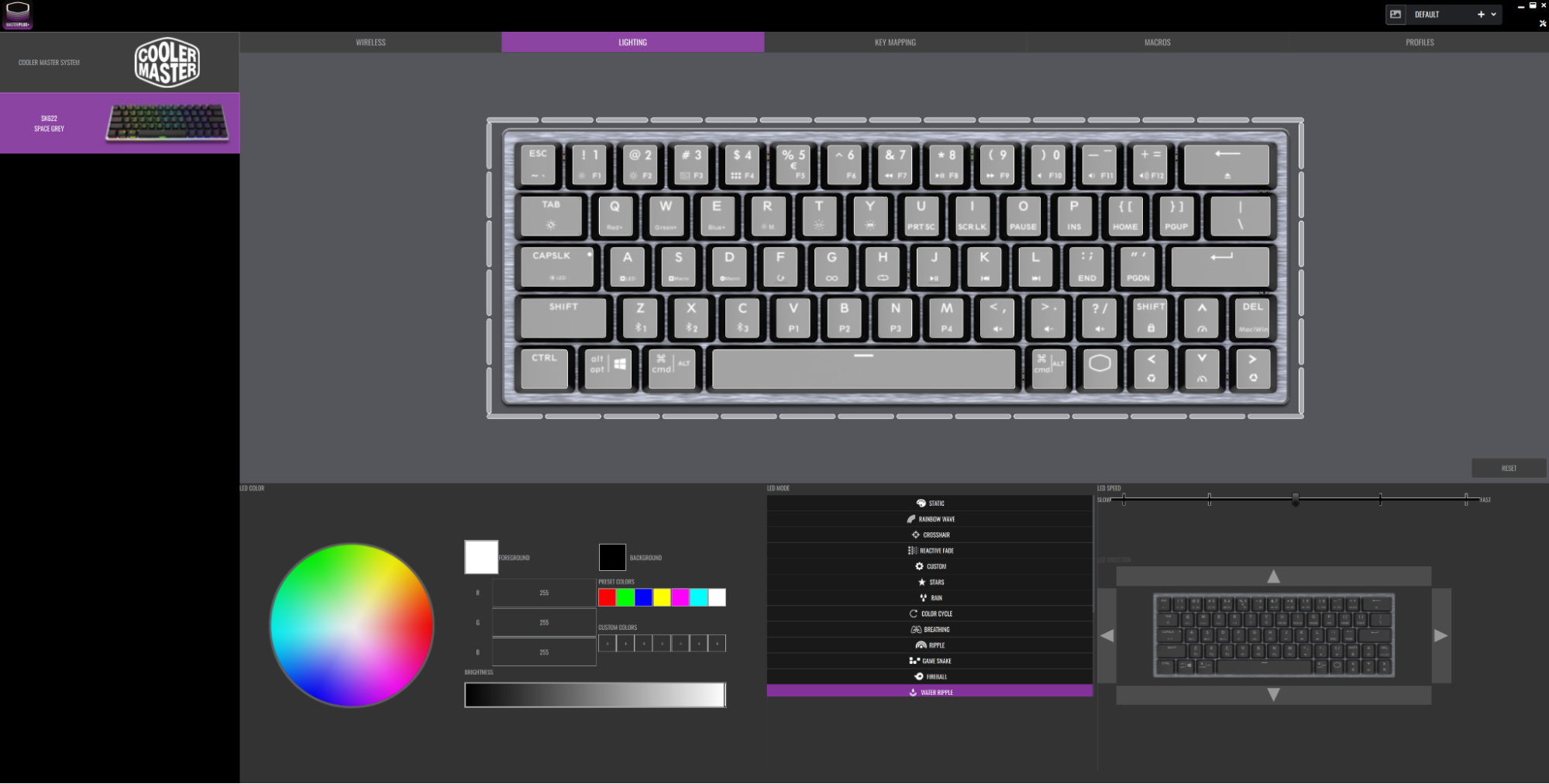Tom's Hardware Verdict
Cooler Master's SK622 60% mechanical Bluetooth keyboard feels much better than its predecessor, thanks to sculpted keycaps and flip-up feet. It's a solid, attractive travel-friendly portable clacker, but for most people there are better options that cost less.
Pros
- +
+ Compact, solid and attractive
- +
+ Wired or wireless (Bluetooth) operation
- +
+ Very travel-friendly
Cons
- -
Short right shift key
- -
Oddly placed delete key
- -
A bit expensive
Why you can trust Tom's Hardware
What makes for the best wireless keyboard depends a lot on what you do with it and how often you travel. But Cooler Master makes a solid effort with the Cooler Master SK622, a slim and solid-feeling 60% mechanical clacker that makes major strides over its predecessor, the SK621, thanks to more traditional sculpted keycaps and flip-up feet that lift up the back end for a more traditional mechanical feel.
If you're after a very compact, travel-friendly mechanical that can work both over Bluetooth and USB, it's a solid option. But if you have just a bit more room in your bag and don't want to deal with the SK622's oddly placed delete key and its small right shift, Keychron's K3 75% keyboard is worth considering as well. That's especially true given the K3 sells for $84 with RGB lighting, while the SK622 sells for between $99 and $117, depending on the switch type and where you buy it.
Cooler Master SK622 Specs
| Switches | TTC low profile Red (tested), Blue or Brown |
| Lighting | Per-key RGB |
| Onboard Storage | 512KB |
| Media Keys | With Fn |
| Connectivity | USB Type-A |
| Cables | 5.91 feet (1.8m), braided |
| Additional Ports | None |
| Keycaps | ABS plastic |
| Software | Cooler Master MasterPlus+ |
| Dimensions (LxWxH) | 11.5 x 4.1 x 1.2 inches (293 x 103 x 30mm) |
| Weight | 0.98 pounds (446g) |
Design of the Cooler Master SK622
The shell of the SK622 appears to be identical to the previous SK621, which is good in that it's compact (1.5 x 4.1 x 1.2 inches) and light (0.98 pounds), yet feels solid. We tested the "space gray" color scheme, (which really looks black and silver), but it's available in "silver white" as well.
Underneath the keys is a nice, brushed-metal plate that adds rigidity and attractiveness, while no doubt helping the light from the RGB switches reflect back toward your eyeballs. Below the metal plate is a light ring that runs around the keyboard, adding some more RGB goodness.
But the company has made some key improvements as well. A pair of flip-up feet let you raise the back of the keyboard up to an angle that, personally, feels more comfortable and familiar to my wrists and fingers. And gone are the very flat keys that gave the SK621 an almost laptop-like typing feel.
Aside from the metal plate and flip-up feet on the bottom, the SK622's shell is fairly devoid of features or other design elements, which gives the keyboard a fairly clean look. There's a wireless/wired switch on the left side and a USB-C port at the center back. Cooler Master includes a nice 5.91-foot braided cable in the box, along with a tool for pulling the keycaps (not that it's really needed). You also get a velvet carrying bag in the box. It's nothing special but appreciated, given Keychron charges $25 for its fancy pouch.
Typing Experience on the Cooler Master SK622
The keycaps here are much more like keycaps you’ll find on traditional mechanical keyboards than the flat keycaps found on the SK621. And that’s despite the SK622 using low profile mechanical switches. Our review model came with Red (linear) TTC switches, but Blue (clicky) and Brown (tactile but non-clicky) varieties are also available. Cooler Master doesn't list details for these low-profile TTC switches, but a listing for the switches on Aliexpress claims they have a total travel of 3.2mm, an actuation point of about 1.2mm and an operating force of 45g (plus or minus 10).
This is my first experience with TTC switches, but the Reds feel very close to Cherry MX Reds. And indeed they have the same rated force as MX Reds, with a total tavel that's just 0.8mm shorter than standard (non-low profile) MX Red switches. The keycaps also feel decent but are ABS plastic rather than more premium PBT. So expect them to get shiny and slicker over months and years of use.
While linear switches are far from my favorite for typing, with the feet flipped up at the back, my fingers mostly felt immediately comfortable typing on the SK622, which is more than I can say for the flat-keycapped SK62. The caps here don't wobble around on their stems, and the build quality as a whole makes for a solid typing feel, despite the keyboard weighing less than a pound.
That said, the half-sized right shift key made me periodically slow down to make sure I hit that smaller target. And whenever I had to use the delete key, I had to stop for a second before remembering its odd placement above the right arrow key. But at least those arrow keys are present, which isn't always the case with keyboards this small. Overall, I think Cooler Master has done about as good a job with the key layout here as you can with something this small. That said, Keychron's K3 is just a bit more than 0.5 inch wider and taller, and its 75% layout feels much closer to full-sized.
Get Tom's Hardware's best news and in-depth reviews, straight to your inbox.
It's also worth noting that the limited key real estate means there’s no dedicated function row, and plenty of other functions and keys are relegated to secondary status, requiring some combination of the Fn key, (which has been replaced by the outline of a Cooler Master logo) and another key or keys to activate. This can be confusing -- and will stay that way unless this is, for the most part, the only keyboard you're using. And while it's good that the company puts all these secondary functions on the keycaps so you don't have to memorize them, it also makes the top of the keyboard look quite busy. In other words, there are a lot of tradeoffs in ease of use and design when you could instead opt for a 75% layout in a keyboard that's barely bigger. You really have to want the 60% layout here.
Gaming Experience on the Cooler Master SK622
I used the Cooler Master SK622 during a few hours of gameplay, both in FPS titles like Doom Eternal and Borderlands 3, as well as my current RTS go-to titles, Becastled and Ancestors Legacy. Here, the keyboard felt much more in its element. The odd placement of a few keys that are occasionally important for typing weren't an issue at all while gaming. And the compact 60% layout made it easy to angle the keyboard for perfect gaming comfort, even on my small desk. For gamers on the go, the SK622 is arguably ideal, save for the fact that there are many similarly sized options that sell for less.
One other thing to note is that serious gamers will probably want to keep the keyboard plugged in via the included USB cable. Cooler Master says the keyboard has N-key rollover in wired mode. But to save battery life, you only get 6-key rollover when connected via Bluetooth.
The company also doesn't make any express claims about battery life. But the fact that it has the same 4000 MAh battery spec as the previous model means unplugged longevity should be decent, especially if you keep the lighting off or low when on the go. Since I tested the keyboard in a mix of wired and wireless scenarios, it never ran down. But as a rough analogue, Keychron's slightly larger 75% K2 also has a 4000 MAh battery and is rated to last up to 240 hours on a charge (with the backlighting off). If you have the SK622’s backlight on and cranked up high, I'd expect to have to charge the battery every couple of days of heavy use.
Software for the Cooler Master SK622
There are plenty of low-priced, compact mechanical keyboards available from the likes of Royal Kludge, Redragon and even Dierya. But most don't come with software -- and honestly, would you want to install Dierya software anyway? But Cooler Master has its MasterPlus+ software, should you want to use it for per-key RGB controls and programming complex macros.
As the company is quick to point out, the software isn't completely necessary, as you can change the lighting and perform many other tasks through keyboard combos. But installing it also means regular checks for firmware updates. And tasks like macro recording and preset jugging are a lot easier to do on a big screen and software, rather than studying a small paper manual to get the key combos right. MasterPlus+ is simply laid out and was stable during my time using it. It's there if you need it, just like Sarah's friends at the end of Labyrinth.
Bottom Line
The Cooler Master SK622 is a solid, compact travel-friendly clacker that's a major improvement over its predecessor. And thanks to simple but refined software and a mostly minimal design, it looks and feels more polished than most of the small keyboards from lesser-known brands. That partially makes up for the $119 MSRP, but there are plenty of very good compact keyboards available for less. Also note that pricing can vary depending on your choice of switch. For instance, when I wrote this the Red-switch model was selling for $117, but the version with Blue switches was a more reasonable $100.
If you're after a mechanical keyboard specifically for on-the-go gaming that feels familiar and is built for frequent travel, Cooler Master's SK622 is a good option--especially if you want to avoid the no-name models that can sell for less than half as much. But for most, especially those who type regularly as well as game and don't need such long battery life, the Keychron K3 is a better option at $84 with hot-swappable switches. If you can live with white backlighting rather than RGB, the K3 starts at just $74. It doesn't feel as rigid as the SK622, but its slightly larger frame and 75% layout is much more friendly for touch typists, without taking up much more room on a desk or in your bag.
After a rough start with the Mattel Aquarius as a child, Matt built his first PC in the late 1990s and ventured into mild PC modding in the early 2000s. He’s spent the last 15 years covering emerging technology for Smithsonian, Popular Science, and Consumer Reports, while testing components and PCs for Computer Shopper, PCMag and Digital Trends.







